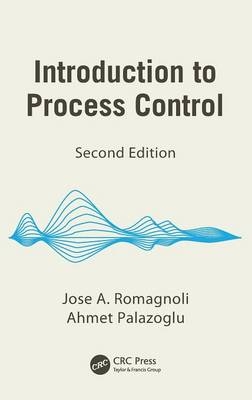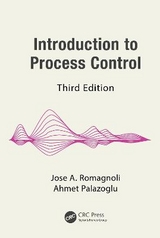
Introduction to Process Control
Crc Press Inc (Verlag)
978-1-4398-5486-0 (ISBN)
- Titel erscheint in neuer Auflage
- Artikel merken
Teaching & Learning Principles
Presents a concept first followed by an example, allowing students to grasp theoretical concepts in a practical manner
Uses the same problem in each chapter, culminating in a complete control design strategy
Includes 50 percent more exercises
Content
Defines the traditional and expanded roles of process control in modern manufacturing
Introduces the link between process optimization and process control (optimizing control), including the effect of disturbances on the optimal plant operation, the concepts of steady-state and dynamic backoff as ways to quantify the economic benefits of control, and how to determine an optimal transition policy during a planned production change
Incorporates an introduction to the modern architectures of industrial computer control systems with real case studies and applications to pilot-scale operations
Discusses the expanded role of process control in modern manufacturing, including model-centric technologies and integrated control systems
Integrates data processing/reconciliation and intelligent monitoring in the overall control system architecture
Web Resource
The book’s website offers a user-friendly software environment for interactively studying the examples in the text. The site contains the MATLAB® toolboxes for process control education as well as the main simulation examples from the book. Access the site through the authors’ websites at www.pseonline.net and www.chms.ucdavis.edu/research/web/pse/ahmet/
Drawing on the authors’ combined 50 years of teaching experiences, this classroom-tested text is designed for chemical engineering students but is also suitable for industrial practitioners who need to understand key concepts of process control and how to implement them. The authors help readers see how traditional process control has evolved into an integrated operational environment used to run modern manufacturing facilities.
Jose A. Romagnoli holds the Cain Chair in Process Systems Engineering in the Department of Chemical Engineering and is the director of the Laboratory for Process Systems Engineering at Louisiana State University. He earned a PhD in chemical engineering from the University of Minnesota. Dr. Romagnoli has authored more than 300 international publications and was awarded the Centenary Medal of Australia for his contributions to chemical engineering. His research covers all aspects of process systems engineering, including data processing and reconciliation, modeling of complex systems, advanced model-based control, intelligent process monitoring and supervision, and plant-wide optimization. Ahmet Palazoglu is a professor of chemical engineering and materials science at the University of California, Davis. He earned a PhD in chemical engineering from Rensselaer Polytechnic Institute. Dr. Palazoglu has authored more than 150 publications and has taught short courses to academic and industrial audiences on process monitoring applications. His research interests include process control, nonlinear dynamics, process monitoring, and statistical modeling.
INTRODUCTION
Why Process Control?
Historical Background
Role of Control in Process Industries
Objectives of Control
Summary
Continuing Problem
References
Definitions and Terminology
Concepts and Definitions
Control Design Problem
Control System Design
Control Design Project
Summary
Continuing Problem
References
MODELING FOR CONTROL
Basic Concepts in Modeling
Why Is Process Modeling Necessary?
Classification of Models
Types of Models
Degrees of Freedom
Models and Control
Summary
References
Development of Models from Fundamental Laws
Principles of Modeling
Models Based on Fundamental Laws
Modeling of Processes Involving Chemical Reactions
Modeling of Complex Systems
Distributed Parameter Systems
Numerical Solution of Model Equations
Summary
Continuing Problem
References
Input–Output Models: The Transfer Function
Linear (Linearized) Model
Concept of Transfer Function
Transfer Functions of Single-Input Single-Output Processes
Properties of Transfer Functions
Nonrational Transfer Functions
Summary
Continuing Problem
Models from Process Data
Development of Empirical Models
Model Structures
Process Reaction Curve Method
Regression in Modeling
Summary
Continuing Problem
References
PROCESS ANALYSIS
Stability
Stability of Linear Systems
Input–Output Stability
Routh’s Criterion
Root-Locus Method
Direct Substitution Method
Summary
References
Dynamic Performance
Input Types
First-Order Processes
Second-Order Processes
Multicapacity Processes
Effect of Zeros
Effect of Time Delays
Summary
Continuing Problem
Frequency Response
What Is Frequency Response?
Complex Numbers in Polar Coordinates
Construction of Frequency Response
Evaluation of Frequency Response
Frequency Response of Common Systems
Bode Diagrams
Nyquist Diagrams
Systems in Series
Summary
Continuing Problem
FEEDBACK CONTROL
Basic Elements of Feedback Control
Feedback Control Problem
Control Law
Closed-Loop Transfer Functions
Analysis of Individual Terms in PID Controllers
Practical Issues in PID Design
Summary
Continuing Problem
Reference
Stability Analysis of Closed-Loop Processes
Closed-Loop Stability
Routh’s Criterion
Root-Locus Method
Modeling Errors
Frequency Response Methods
Summary
Continuing Problem
Feedback Control Design
Design Objectives
Controller Tuning Techniques
Comparing the Methods
Summary
Continuing Problem
References
MODEL-BASED CONTROL
Model-Based Control
Feedforward Control
Delay Compensation (Smith Predictor)
Internal Model Control
Summary
Continuing Problem
References
Model Uncertainty and Robustness
IMC Structure with Model Uncertainty
Description of Model Uncertainty
IMC Design under Model Uncertainty
Summary
References
Model Predictive Control
General Principles
Dynamic Matrix Control
Process Constraints
State-Space Formulation of MPC
Summary
Continuing Problem
References
MULTIVARIABLE CONTROL
Multivariable Systems: Special Cases
Cascade Control
Ratio Control
Split-Range Control
Override Control
Summary
Continuing Problem
References
Multivariable Systems
Characteristics of Multivariable Processes
Modeling of Multivariable Processes
Transfer Functions of Multivariable Processes
Multivariable Feedback Control Structure
Summary
Continuing Problem
References
Design of Multivariable Controllers
Multiple-Input–Multiple-Output Feedback Analysis
RGA Interaction Measure
Multiloop Controller Design
Design of Noninteracting Control Loops: Decouplers
Summary
Continuing Problem
References
CONTROL IN MODERN MANUFACTURING
Practical Control of Nonlinear Processes
Operating Regime Modeling Approach
Gain-Scheduling Controller
Multimodel Controller Design
Summary
References
Process Optimization and Control
Process Optimization
Optimizing Control of Disturbances
Dynamic Optimization and Transition Planning
Summary
References
Industrial Control Technology
Evolution of Industrial Control Technology
Generic Industrial Control Systems Architecture
Summary
Continuing Problem
References
Role of Process Control in Modern Manufacturing
Expanded Role of Control in Modern Manufacturing
Model-Centric Technologies
Integrated Control Systems
Summary
References
Data Processing and Reconciliation
Dealing with Missing Points
Outliers
Characterizing Process Data
Modeling Process Data
Data Reconciliation
Issues in Data Reconciliation
Process Monitoring
Process Monitoring
Statistical Process Control
Principal Component Analysis
Multivariate Performance Monitoring
Fault Diagnosis and Classification
Controller Performance Monitoring
Summary
References
Appendix A: Linearization
Appendix B: Laplace Transformation
Appendix C: Matrix Operations
Appendix D: Basic Statistics
Index
Additional Reading and Exercises appear at the end of each section.
| Erscheint lt. Verlag | 16.3.2012 |
|---|---|
| Reihe/Serie | Chemical Industries |
| Zusatzinfo | 850-900 equations; 53 Tables, black and white; 396 Illustrations, black and white |
| Verlagsort | Bosa Roca |
| Sprache | englisch |
| Maße | 156 x 235 mm |
| Gewicht | 1070 g |
| Themenwelt | Naturwissenschaften ► Chemie ► Technische Chemie |
| Technik ► Elektrotechnik / Energietechnik | |
| ISBN-10 | 1-4398-5486-6 / 1439854866 |
| ISBN-13 | 978-1-4398-5486-0 / 9781439854860 |
| Zustand | Neuware |
| Haben Sie eine Frage zum Produkt? |
aus dem Bereich



